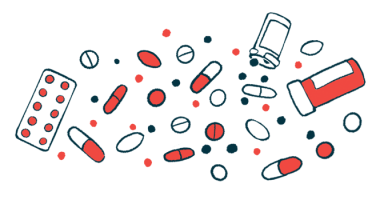1 in 10 AAV patients fails to respond to rituximab treatment: Study
These new or relapsing patients did not achieve remission at 3 months

About 1 in 10 people with ANCA-associated vasculitis (AAV) failed to achieve complete remission at three months after starting induction treatment with rituximab, according to a small study in France.
Poor responders were more likely to have symptoms in a specific area of the body — a localized form of AAV — and less likely to have previously received high-dose pulse methylprednisolone or a combination of the antibiotics sulfamethoxazole and trimethoprim.
All of these patients eventually got better at six months following additional or higher-dose treatment.
But “our work highlights the importance of identifying [rituximab]-resistant patients to propose individualized induction treatment,” the researchers wrote.
The study, “Rituximab resistance at 3 months of induction therapy in newly diagnosed or relapsing ANCA associated vasculitis: a French multicenter study,” was published in Joint Bone Spine.
Patients with GPA and MPA show resistance to rituximab treatment
AAV occurs when self-reactive antibodies called ANCAs cause neutrophils, a type of immune cell, to launch an attack against small blood vessels, causing them to become inflamed and damaged. Symptoms of AAV can occur anywhere in the body.
Sold as Rituxan in the U.S. and MabThera in Europe, with biosimilars available, rituximab is a medication that lowers the count of B-cells, a type of immune cells. B-cells make antibodies, including those driving AAV. The therapy is administered directly into the bloodstream.
Its use is recommended both as part of induction — or starting treatment — and maintenance therapy for granulomatosis with polyangiitis (GPA) and microscopic polyangiitis (MPA), the most common types of AAV. However, for reasons that remain unclear, rituximab does not work well for everyone.
To know more, a team of researchers in three hospitals across France looked back at the clinical data of 121 adults who had received rituximab induction treatment and had at least three months of follow-up data. All of the patients had newly-diagnosed or relapsing AAV, and none had been previously treated with rituximab.
Resistance to rituximab, assessed after three months of treatment, was defined as uncontrolled disease at one month or a disease flare between months 1-3 — regardless of whether remission was achieved — and the need for additional treatment. A disease flare is a period of symptom worsening.
Six patients were excluded from the analysis as they did not achieve complete remission by three months but achieved remission at six months without receiving additional treatment.
The median age of the 116 included patients — 69 men and 47 women — was 56 years. Nearly two-thirds (65%) had GPA, and the remaining one-third (35%) had MPA. Slightly more than two-thirds (67%) had relapsing AAV, while 21% had localized disease. The most common disease manifestation was lung involvement, seen in 51% of patients.
Most patients (60%) received two infusions of 1 g of rituximab, separated by two weeks.
A total of 14 patients (12%) showed resistance to rituximab at three months. Among them, nine had severe disease. Eight of these patients showed uncontrollable disease, with new/worsening symptoms or no clinical improvement, after one month; the remaining six had flares sometime between one and three months of treatment.
There was no significant difference between poor responders and responders in terms of demographic criteria, ANCA type, disease status (initial or relapse), or organ involvement, the team noted.
However, the proportion of patients with a localized form of the disease was significantly higher among poor responders than among those who responded well to rituximab (43% vs. 18%).
Those who showed resistance to rituximab were significantly less likely to have received high-dose pulse methylprednisolone (21% vs. 58%) or a preventive combination treatment with sulfamethoxazole and trimethoprim, two commonly given antibiotics (57% vs. 85%). Moreover, their median prednisone dose at the three-month mark was about two times higher (28 vs. 15 milligrams per day).
“These patients presented more often with a localized disease and were less often treated with initial methylprednisolone pulse and sulfamethoxazole [plus] trimethoprim,” the researchers wrote.
Patients resistant to rituximab given additional treatment
Similar trends were observed for the subgroup of patients with GPA.
Of the 14 people who failed to respond to rituximab, seven (50%) received additional immosuppressive treatment and the other half received increased glucocorticoid therapy.
Among additional immunosuppressive therapy, cyclophosphamide was the most common, given to four patients. This was followed by plasma exchange, administered to three patients, and into-the-vein (intravenous) immunoglobulin, which was given to two patients. These two procedures are meant to clear the blood of self-reactive antibodies. Two patients received both cyclophosphamide and plasma exchange.
All of these non-responsive patients achieved remission at the six-month mark.
The main challenge in treating refractory patients is not only in achieving remission but decreasing the risk of cardiovascular and infectious events.
A total of 23 people (20%) died during a median follow-up of nearly eight years, but none during the first three months of treatment. Three of these patients had resistance to rituximab. A total of 10 patients died from an infection, including four who died from infection with SARS-CoV-2, the virus that causes COVID-19.
There were no significant associations between rituximab resistance and infections or cardiovascular events, but this was “possibly due to a lack of statistical power,” the team wrote.
“The main challenge in treating refractory patients is not only in achieving remission but decreasing the risk of cardiovascular and infectious events,” the researchers wrote.
Being able to identify which individuals are likely to resist to rituximab treatment “appears important to propose individualized induction treatment using alternatives,” they added.








